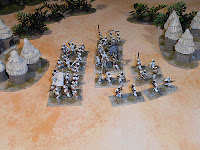 For the casual reader who missed the first installment, my Colonial Dervish army of the late 19th century had no opponents; no British, French or Abyssinian army. For the past five years, I have focused my efforts and collection around the 18th century and the challenge here was see what I could do with a very large Dervish army. As you will see from the photos, the collection pre-dates the Mahdist rebellion, as none of the Ansar wear patches and actually my saving grace.
For the casual reader who missed the first installment, my Colonial Dervish army of the late 19th century had no opponents; no British, French or Abyssinian army. For the past five years, I have focused my efforts and collection around the 18th century and the challenge here was see what I could do with a very large Dervish army. As you will see from the photos, the collection pre-dates the Mahdist rebellion, as none of the Ansar wear patches and actually my saving grace.Rebasing
 The majority of “Ansar” were rebased to represent the hordes of the less inclined, while the “Fuzzy Wuzzy” to warband of the enthusiastic. In DBA terms, the rebasing project delivered; 6 Generals, 11 Cv, 3 LH, 16 Cm, 3 LCm, 24 Hd, 54 Wb, 13 Bd, 20 Ps/Sk/Sh, 2 Ms and 4 baggage elements, bringing a total of 39 mounted and 113 foot elements. Quite a number, so my initial research gleaned army lists from the Renaissance books and any other lists available on the internet to see what could best be used.
The majority of “Ansar” were rebased to represent the hordes of the less inclined, while the “Fuzzy Wuzzy” to warband of the enthusiastic. In DBA terms, the rebasing project delivered; 6 Generals, 11 Cv, 3 LH, 16 Cm, 3 LCm, 24 Hd, 54 Wb, 13 Bd, 20 Ps/Sk/Sh, 2 Ms and 4 baggage elements, bringing a total of 39 mounted and 113 foot elements. Quite a number, so my initial research gleaned army lists from the Renaissance books and any other lists available on the internet to see what could best be used. The Campaign
Looking at the first map, the major powers at the turn of the 18th century were the Sultanate of Sennar and the Kingdom of Darfur. The Ottomans I already have and Ethiopians were not in the planning, I needed to create my own lists for the “other”. These would represent Beja tribal groupings of the Sudan, chiefly the Ababda, Bisharin (eastern Sudan), Hadendoa (No. of Abyssinia), Beni-Amer (So. Coastal), Amarar (No. Coastal), Shukuria, Hallenga and the Hamran.
So for our campaign, the six nations will represent the Ottomans, the Sultanate of Sennar, the Kingdom of Fung and three Beja groups; the Bisharin, the Amarar and the Hadendoa. With the exception of the Ottomans, the remaining five will come from the generous pool of 152 elements. The infantry Hd and Wb are based 5, 4 or 3 to a base so as to add variation to army composition.
Army standards
 I had posed a question about flags and would they have had religious themes or Arabic script. Although some enclaves held to their form of Christianity, the conversion to Islam on the whole had been accomplished by 1600 as all Churches had been converted to Mosques. Those areas which still resisted the change were far south and bordered Abyssinia. So, the Arabic text remains, despite my initial sketches of Saints on horseback or crosses.
I had posed a question about flags and would they have had religious themes or Arabic script. Although some enclaves held to their form of Christianity, the conversion to Islam on the whole had been accomplished by 1600 as all Churches had been converted to Mosques. Those areas which still resisted the change were far south and bordered Abyssinia. So, the Arabic text remains, despite my initial sketches of Saints on horseback or crosses. Fortifications
 This is what I would describe as a “you never know” project; although sieges are handled off-table, perhaps to set a level of ambiance it would be nice to have a fort or fortified position as a BUA. Massawa was the Ottoman Empire’s most Southern fort and my readings of military architecture of the area did find mention of “castles” and forts dotted along the length of the Nile.
This is what I would describe as a “you never know” project; although sieges are handled off-table, perhaps to set a level of ambiance it would be nice to have a fort or fortified position as a BUA. Massawa was the Ottoman Empire’s most Southern fort and my readings of military architecture of the area did find mention of “castles” and forts dotted along the length of the Nile. With certainty, the Ottoman forts did have artillery, but I could find nothing for the Sultanate or the Kingdom of Fung. Generally, forts were constructed from mud brick and of a sufficient height to deter an escalade.
Campaign background
 No actual start date has been set as early 18th century could be described as a period of internal warfare among the Beja tribes, a slow deterioration of the Sultanate as the Kingdom of Fung ascended while the Ottomans remained content sitting on the fence. For game purpose, Khartoum is central to all six kingdoms.
No actual start date has been set as early 18th century could be described as a period of internal warfare among the Beja tribes, a slow deterioration of the Sultanate as the Kingdom of Fung ascended while the Ottomans remained content sitting on the fence. For game purpose, Khartoum is central to all six kingdoms.On to battle!
Cheers,



